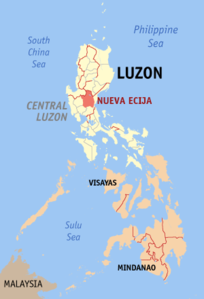Nueva Ecija
| Basic data | |
|---|---|
| Region : | Central Luzon |
| Capital : | Palayan City |
| Population : | 2,151,461 August 1, 2015 census
|
| Population density : | 374 inhabitants per km² |
| Area : | 5,751.33 km² |
| PSGC : | 034900000 |
| structure | |
| - Highly urbanized cities | |
| - provincial cities | 5 |
| - municipalities | 27 |
| - Barangays | 849 |
| - electoral districts | 4th |
| Location of the province in the Philippines | |

|
|
Coordinates: 15 ° 36 ′ N , 121 ° 0 ′ E Nueva Ecija is a province of the Philippines in the Central Luzon regionon the main island of Luzon .
The name Nueva Ecija is derived from the Spanish city Écija , located on the Río Genil between the two Andalusian cities of Cordoba and Seville . The capital of Nueva Ecija is Palayan City . In 2015, 2,151,461 people lived in the 5751.33 km² province. In addition to Tagalog (share: 60%), Kapampangan and Ilokano are spoken.
geography
The province is located in the middle of Luzon and has no connection to the sea. In the southwest near the border to Pampanga the land is swampy. Further east it is very flat at first. Then the terrain gradually rises up to the Sierra Madre , in this area lies the Aurora Memorial National Park and the Minalungao National Park . To the north is the Cordillera Central and the Caraballo Mountains . Nueva Ecija is surrounded by the provinces of Pampanga in the southwest, Tarlac in the west, Pangasinan in the northwest, Nueva Vizcaya in the northeast, Aurora in the east and Bulacan in the south.
Cities and municipalities
Nueva Ecija is divided into 5 cities and 27 municipalities, which in turn in 849 barangays split:
- Cities
- Boroughs
economy
The main source of income is agriculture. Corn, eggplant , onions, and sugar cane are produced in large quantities. In some communities there are large mango or banana plantations . There are also countless rice fields in the great plain of Nueva Ecija. This makes the province the most productive rice producer in the country. Nueva Ecija is also the leader in onion cultivation in Southeast Asia . Most of the onions come from the Bongabon community . The hydropower plant at the Pantabangan reservoir plays an important role in the energy supply .
Even natural resources such as copper and manganese were detected in General Tinio, Caranglan and Pantabangan.
population
Nueva Ecija was settled in the last century by Tagalogs and Ilokanos, who came from neighboring provinces like Pangasinan . Today most of the Ilokanos live in the north of the province. There they, like the Tagalogs, hold fast to the traditions of their people. Nevertheless, today's culture is strongly influenced by the Christian faith. Occasionally there are also small communities in the Caraballo Mountains or the Sierra Madre , where Ilongots , Aetas or Negritos live.
history
The Arubo archaeological excavation site is located in the province ; hand axes from the Neolithic period that are between 16,500 and 6,000 years old have been found during excavations . From 1902 to 1906, Epifanio de los Santos was the first native Filipino governor of the province.
